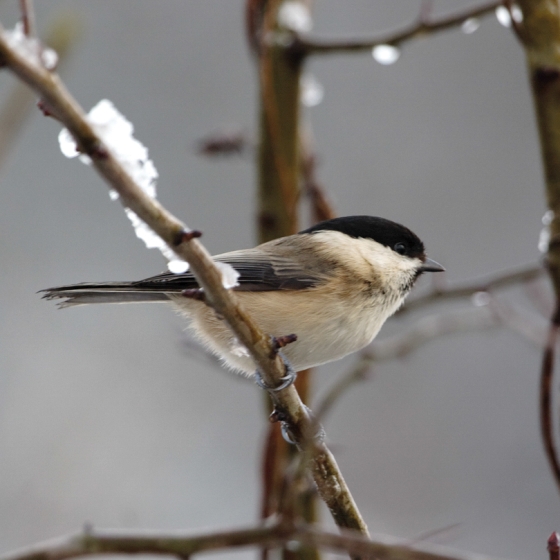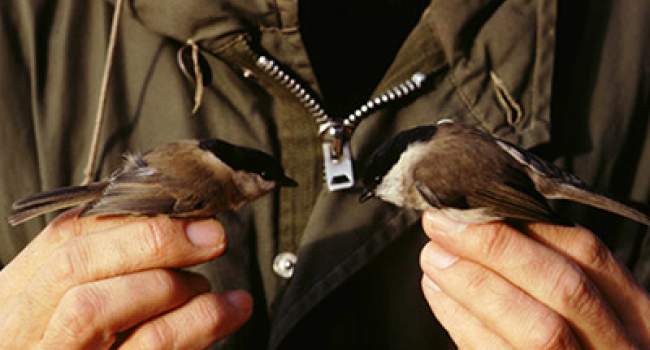Willow Tit
Poecile montanus (von Baldenstein, 1827)
WT
 WILTI
WILTI  14420
14420

Family: Passeriformes > Paridae

The endearing Willow Tit, generally timid with a buzz-like contact call, has suffered the worst population decline of a resident UK bird in recent times.
The Willow Tit is best separated from the Marsh Tit by its call, as these species look very alike. Habitat is also a good indicator; Willow Tit prefer damp, young, regenerating woodland containing old dead wood and remain on or near their territory all year round. Adults excavate their own nest holes in April, and lay up to eight eggs in a single annual breeding attempt. Fledglings disperse a few kilometres away.
Willow Tit numbers have fallen sharply since the mid-1970s and the species has been Red-listed in the UK since 2022. It has also undergone range contraction, becoming locally extinct in many of its former haunts, especially in southern and eastern Britain. Habitat deterioration is thought to be the main driver of these changes, although this species might also be susceptible to competition from other tit species and predation pressure.
Exploring the trends for Willow Tit
Our Trends Explorer will also give you the latest insight into how the UK's Willow Tit population is changing.
trends explorerIdentification
Willow Tit identification is often difficult. The following article may help when identifying Willow Tit.
SONGS AND CALLS
Listen to example recordings of the main vocalisations of Willow Tit, provided by xeno-canto contributors.
Call
Song
Develop your bird ID skills with our training courses
Our interactive online courses are a great way to develop your bird identification skills, whether you're new to the hobby or a competent birder looking to hone your abilities.
Browse training coursesStatus and Trends
Population size and trends and patterns of distribution based on BTO surveys and atlases with data collected by BTO volunteers.
CONSERVATION STATUS
This species can be found on the following statutory and conservation listings and schedules.
POPULATION CHANGE
Willow Tits have been in decline since the mid 1970s, and have become locally extinct in an ever-growing number of former haunts. The UK conservation listing was upgraded from amber to red in 2002. Atlas surveys during 2008-11 found that the species had virtually disappeared from the southeastern part of its English range since 1988-91 (Balmer et al. 2013). The continuing decline in the CBC/BBS index through the 1990s, following a brief period of stability during the 1980s, is replicated in the CES abundance trend. All UK breeding records since 2010 should be forwarded to the Rare Breeding Birds Panel, who have developed specific recording criteria. Willow Tit has shown a decline across Europe since 1980, but has declined to a lesser extent in central and eastern Europe than in the north, west and south (PECBMS: PECBMS 2007, PECBMS 2020a>).
| UK breeding population |
-96% decrease (1967–2022) 
|
Exploring the trends for Willow Tit
Our Trends Explorer will also give you the latest insight into how the UK's Willow Tit population is changing.
trends explorerDISTRIBUTION
Owing to historic declines, by 2007–11 the distribution of Willow Tits was concentrated in a crescent from northeast England to south Wales with several scattered outposts. The species is very sedentary so, not surprisingly, the winter and breeding distributions closely match one another. Declines continue and some outlying populations on these maps may no longer exist.
Occupied 10-km squares in UK
| No. occupied in breeding season | 558 |
| % occupied in breeding season | 18 |
| No. occupied in winter | 691 |
| % occupied in winter | 23 |
European Distribution Map
European Breeding Bird Atlas 2
Breeding Season Habitats
| Most frequent in |
Scrub 
|
Relative frequency by habitat
Relative occurrence in different habitat types during the breeding season.

DISTRIBUTION CHANGE
Willow TIts have virtually disappeared from the southeastern part of their English range since 1988–91. Apparent hot spots in southern England, East Anglia and the southern Midlands have vanished in the space of just two decades. Despite a rather constant population decline, range loss accelerated from 10% between the 1968–72 Breeding Atlas and the 1988–91 Breeding Atlas to 50% subsequently and has likely continued.
Change in occupied 10-km squares in the UK
| % change in range in breeding season (1968–72 to 2008–11) | -55.1% |
| % change in range in winter (1981–84 to 2007–11) | --42.6% |
SEASONALITY
Willow Titi is a localised and declining resident, recorded throughout the year.

Movement
Information about movement and migration based on online bird portals (e.g. BirdTrack), Ringing schemes and tracking studies.
RINGING RECOVERIES
View a summary of recoveries in the Online Ringing Report.
Biology
Lifecycle and body size information about Willow Tit, including statistics on nesting, eggs and lifespan based on BTO ringing and nest recording data.
PRODUCTIVITY & NESTING
Exploring the trends for Willow Tit
Our Trends Explorer will also give you the latest insight into how the UK's Willow Tit population is changing.
trends explorerSURVIVAL & LONGEVITY
View number ringed each year in the Online Ringing Report
Exploring the trends for Willow Tit
Our Trends Explorer will also give you the latest insight into how the UK's Willow Tit population is changing.
trends explorerBIOMETRICS
Wing Length 
|
Adults | 59.7±2 | Range 57–63mm, N=702 |
| Juveniles | 59.5±1.8 | Range 57-62mm, N=716 | |
| Males | 60.4±1.6 | Range 58–63mm, N=62 | |
| Females | 59±1.9 | Range 56–62mm, N=94 |
Body Weight 
|
Adults | 10.0±0.7 | Range 9.00–11.0g, N=500 |
| Juveniles | 9.90±0.6 | Range 9.00–10.9g, N=544 | |
| Males | 10.2±0.7 | Range 9.20–11.0g, N=43 | |
| Females | 10.0±0.8 | Range 8.70–11.4g, N=68 |
Feather measurements and photos on featherbase 
CODES & CLASSIFICATION
Ring size 
|
A |
Field Codes 
|
2-letter: WT | 5-letter code: WILTI | Euring: 14420 |
For information in another language (where available) click on a linked name
Research
Interpretation and scientific publications about Willow Tit from BTO scientists.
CAUSES AND SOLUTIONS
Causes of change
Willow Tits have declined in woodland, probably because of habitat degradation. How this relates to demographic trends is unclear.
Further information on causes of change
Little evidence is available regarding changes in the demography of this species but CES trends suggest a decline in productivity since 1983 (see above). Lampila et al. (2006) found that adult survival was the main driver of Willow Tit populations in northern Finland, although a study in Norway recorded adult survival of around 50% (Hogstad & Slagsvold 2018) which is in line with the survival rates for Blue Tit and Great Tit published in this report. Both these studies were in boreal forests, so the processes may not be the same as for the British population. The British subspecies shows very different habitat preferences to the Fennoscandian one, preferring wet woodland rather than conifers, emphasising that Continental studies may not be very relevant to population change in the UK.
There are several hypotheses that have been put forward to explain the cause of population declines of Willow Tit. One is that deterioration in the quality of woodland as feeding habitat for this species through canopy closure and increased browsing by deer (Perrins 2003, Siriwardena 2004, Fuller et al. 2005, Newson et al. 2012) has been important. The area of wet woodland and scrub is also thought to have declined as a result of drainage and the occurrence of increasingly dry summers (Vanhinsbergh et al. 2003). A field study based on former CBC sites and other woods that were known to have held the species in the past provided good evidence that the sites still holding Willow Tit tended to be wetter, so drying out of woodlands may have been a factor (Lewis et al. 2007, 2009a, 2009b). Siriwardena (2004) analysed long-term CBC trends and found that, although population trends have been stable in their preferred, wet habitats, Willow Tit have declined in woodland, probably because of habitat degradation.
A second hypothesis is that nest predation pressure, from Jays, Great Spotted Woodpeckers and grey squirrel, for example, has increased, both because some of these predators have grown more abundant (Harris et al. 1995, this report) and because restrictions in nest-site availability are likely to have forced more birds into suboptimal, more vulnerable sites. In the study mentioned above, Siriwardena (2004) found increases in Green Woodpecker abundance on CBC plots at the same time as declines in Willow Tit abundance, but this is unlikely to reflect a causal link - this woodpecker being unrecorded as a nest predator. A negative relationship between Great Spotted Woodpecker and Willow Tit abundance on farmland plots is more likely to reflect a real population effect, but farmland is only a minor habitat for the species, so it is unlikely that such a relationship has biological significance for Willow Tits nationally. There were no significant associations with other avian potential nest predators. Supporting this result, Lewis et al. (2007, 2009a, 2009b) found that sites that were known to have held the species in the past and that were still holding Willow Tits did not differ in the density of potential nest predators. In a study which monitored 128 nests over 2014-18 in Greater Manchester, predation accounted for 60% of the 45% of nests that fai
Thirdly, increases in the local populations of behaviourally dominant, sympatric species such as Blue Tit, Great Tit, Marsh Tit and Nuthatch could have led to increased competition, especially for nest-holes. There is little direct evidence specifically concerning foraging interactions involving Willow Tit in the UK but it is possible that increases in other tit species have placed extra pressure on Willow Tit populations through competition for food or nest sites (Vanhinsbergh et al. 2003). In Lanarkshire, central Scotland, Great and Blue Tits were found commonly to take over the nest sites of Willow Tit (Maxwell 2002, 2003) but it is unclear how widespread this phenomenon is. In the Greater Manchester study mentioned above (Parry & Broughton 2019), eviction by Blue Tits caused 23% of first breeding attempts to fail, but only 3% of second attempts, so the ability to re-lay may limit population level effects of usurpation. Excluding evicted and predated nests, 98% of eggs in this study resulted in fledged chicks, suggesting that competition for food was not an issue at this site, at least during the nestling stage. In the analysis of long-term CBC trends carried out by Siriwardena (2004), no negative relationships were found between Willow Tit and its potential competitors. Again, this was supported by field data from Lewis et al. (2007, 2009a, 2009b), who found that sites that were known to have held the species in the past and that that were still holding Willow Tits did not differ in the density of avian competitors.
Overall, therefore, habitat deterioration is the strongest candidate as the cause of Willow Tit decline nationally. As well as increasing woodland drainage, degradation has been hypothesised to have occurred via a reduction in nest-site availability resulting from falls in the amount of dead wood and number of dead trees in woodland reducing nesting opportunities (Vanhinsbergh et al. 2003). This has yet to be tested formally, however, probably because historical data on quantities of dead wood are not available.
Information about conservation actions
The long-term decline of this species is most likely to have been caused by habitat degradation, and hence conservation actions and policies which aim to restore and create habitat are most likely to benefit this species.
Wet woodland also seems to be a particularly important habitat for Willow Tits, and one study found that soil water content was the only significant difference between sites which were still occupied and those which had been abandoned. This study concluded that "Habitat provision for Willow Tit should involve provision of young woodland patches with moist soils" (Lewis et al. 2009a). Another study identified deadwood of silver birch, elder and alder as the most frequent trees used for nest sites (Parry & Broughton 2019). Deterioration of the woodland understorey is also believed to be important (see Causes of Change section, above); actions to promote understorey habitat could include management to create a more open canopy and to control deer numbers.
It is also possible that increased interspecific competition for food and nest sites might be having some negative effects on local Willow Tit numbers, although the evidence does not suggest that this is likely to be the main cause of the general population decline. Nevertheless, it might be prudent to discourage the increased provision of food and nest boxes within and near Willow Tit strongholds as a precaution.
Links to more studies from ConservationEvidence.com
- Artificial nest site preferences of black-capped chickadees
- The effects of provision of food in winter on a population of the great tit Parus major and the blue tit P. caeruleus
- Calcium supplementation of breeding birds: directions for future research
Read more studies about Willow Tit on Conservation Evidence >
Would you like to search for another species?













Share this page